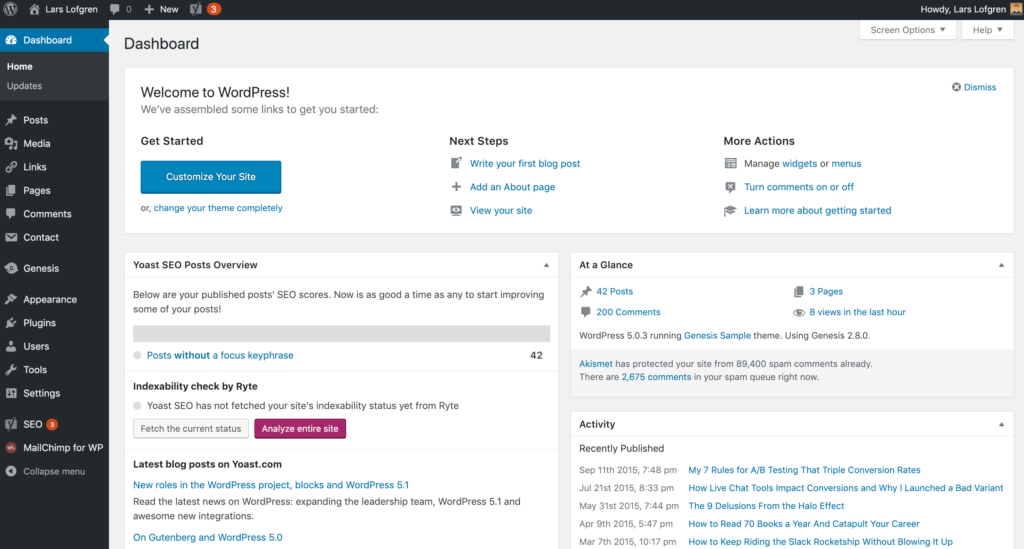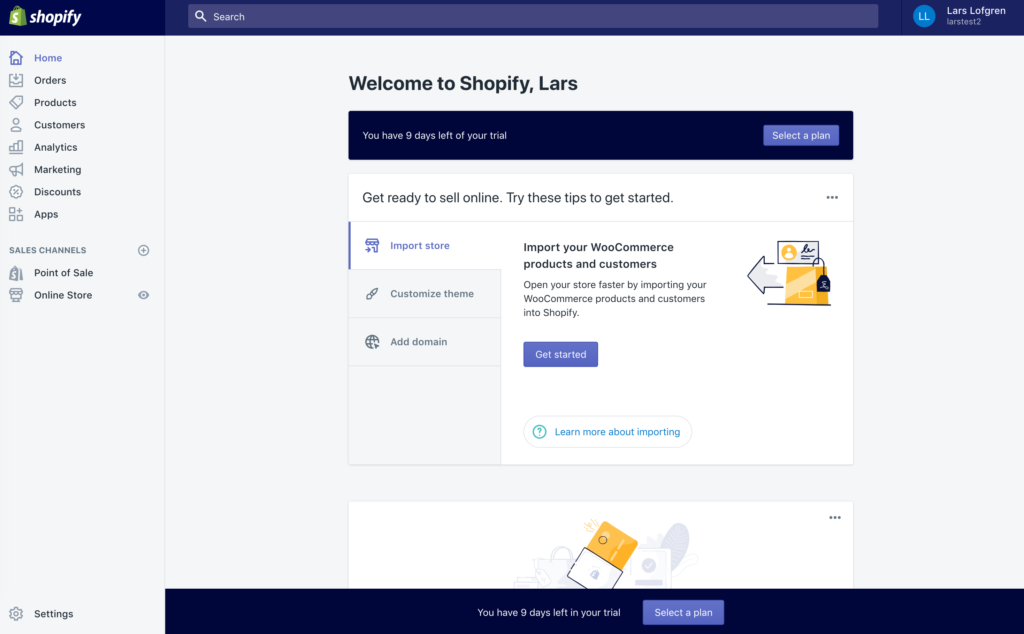In this guide, I’ll walk you through everything you need to know about where to build your online store—whether WordPress ecommerce is the right fit for your business or if a dedicated ecommerce platform like Shopify is the better choice. I’ll answer key questions like:
- Should I launch my store on an ecommerce platform like Shopify?
- Is it better to monetize my content site using a WordPress ecommerce integration like Bluehost with WooCommerce?
- What is the Shopify Buy Button, and when should I use it?
- Once I decide where to build my store, what plugins and tools do I need—and how do I install them?
Here’s the short version: The decision mostly hinges on one question—are you building a site centered on content and SEO, or is ecommerce your main focus?
Take a moment to answer that honestly. Your answer will shape the platform that’s right for you.
WordPress Ecommerce Website vs. Shopify Store
This part is straightforward. If your site is 100% content-driven or 100% ecommerce-focused, the right platform becomes obvious.
What WordPress excels at: Content
WordPress has been the leading CMS for over 20 years—and for good reason. It’s the best choice if you’re pursuing a content marketing or SEO strategy. It’s optimized for content-rich websites, offers exceptional control over URLs and metadata, and gives you complete ownership of your publishing workflow.

No other platform matches WordPress for content scalability, SEO plugins, editorial features, and overall flexibility. That’s why it remains the go-to CMS for content-heavy sites around the world.
What Shopify excels at: Ecommerce
If you’re serious about selling products online, Shopify is your best bet. It’s widely recognized as a leading ecommerce platform in 2025, offering unmatched ease of use, built-in selling features, secure checkout, and scalable plans for businesses of any size.

Even better—Shopify scales effortlessly with your business, from your first sale to your millionth. It’s enterprise-ready yet still beginner-friendly. Whether you’re selling one item or managing a massive catalog, Shopify supports every stage of your growth.
Why Shopify Is the Right Choice for Most Ecommerce Sites
As much as I love WordPress, it’s not built for ecommerce out of the box—even with plugins like WooCommerce. Shopify, on the other hand, was designed from the ground up to run online stores.
Here are must-have features for any modern ecommerce website:
- Robust shopping cart functionality
- Seamless, mobile-optimized checkout
- Multiple payment gateways (including accelerated checkout options)
- Inventory, variants, and multi-location fulfillment
- Real-time shipping rates and label printing
- Easy product page creation and bulk management
- Detailed revenue, cohort, and product performance analytics
- Returns, refunds, and exchange workflows
- Sales channel integrations (Amazon, Instagram, Facebook, TikTok, Etsy, eBay)
Shopify includes all of this with minimal setup. You also get PCI compliance, built-in fraud tools, discounting, abandoned cart recovery, and a massive ecosystem of themes, apps, and developers to customize anything through Shopify’s API.
Ready to get started? Sign up for Shopify here.
Already have a site elsewhere? Here’s our guide on how to transfer your website to Shopify.
Shopify’s Only Real Weakness: Blogging
Shopify’s biggest drawback is its native blogging. It exists, but it’s basic compared to WordPress—especially if you need advanced taxonomy, editorial workflows, or deep SEO customization.
If you’re just posting company announcements occasionally, it’s fine. But if you’re serious about SEO, content marketing, or building an organic traffic engine, Shopify’s blog tools are limiting.
The companies that benefit most from Shopify’s blog usually don’t need a full-fledged content program.
So what should you do if you want a powerful ecommerce store and a high-performing blog?
This is where things get interesting.
Let’s say your Shopify store is up and running and doing great—but now you want to launch a content hub or SEO-focused blog to boost traffic and sales.
Your best move? Use Shopify for your store and WordPress for your blog. Many successful sites run both platforms together without friction.
It’s more common than you might think—and it works.
How to Combine Shopify and WordPress
Use one platform on your main domain and the other on a subdomain. For example:
- WordPress blog at company.com
- Shopify store at store.company.com
This setup is simple and doesn’t require custom development. Most domain registrars, WordPress hosts, and Shopify accounts make it easy to configure subdomains and install each platform where it belongs.
Which Should Go on the Subdomain?
You can also flip the structure:
- Shopify store at company.com
- WordPress blog at blog.company.com
So how do you choose?
Anchor your primary growth engine on the root domain. If you’re optimizing product and category pages to rank, put Shopify on company.com. If your blog drives most of your organic traffic, keep WordPress on company.com.
Subdomains can rank well when implemented properly, but consolidating the thing you want to rank most on the root makes internal linking, analytics, and link equity simpler.
To summarize: decide which side of your site (content or store) matters more for SEO. Put that platform on your main domain and the other on a subdomain.
What If SEO Doesn’t Matter to You?
If you’re focused on paid advertising, influencers, or direct channels instead of SEO, then subdomain vs. main domain doesn’t matter much. Install the second tool wherever it’s simplest and keep your stack lightweight.
When It Makes Sense to Use WordPress for Ecommerce
There are still strong use cases for using WordPress as your ecommerce platform—especially if:
- You already have an established WordPress site with strong content and traffic.
- You’re running a small store with a limited catalog (for example, 10–20 products).
- Your store is a side project or low-maintenance revenue stream.
If you’re already deep into the WordPress ecosystem and want to add a straightforward store without launching a full ecommerce operation, stick with WordPress and use an ecommerce plugin like WooCommerce.
WooCommerce is the most widely supported ecommerce plugin for WordPress and works well if you want to keep everything under one platform. You’ll also want essentials like reliable hosting, a performance-friendly theme, caching, security, backups, a payments gateway, and shipping/tax extensions.
If staying within WordPress is your top priority, WooCommerce is your best bet.
Test Ecommerce on WordPress with Shopify Starter
If you want to dip your toe into ecommerce before committing, the Shopify Starter plan (formerly Shopify Lite) lets you sell via links and the Buy Button without building a full online store. It’s a low-cost way to take payments from a WordPress site or social profiles.
Shopify did launch an official WordPress ecommerce plugin years ago, but it was discontinued in 2017. Today, Shopify’s supported approach is the Buy Button sales channel (or a third-party connector if you want deeper WordPress control).
Good to know: the Buy Button sales channel is included on all Shopify plans, including Starter. You create the button in Shopify and embed it on any site, including WordPress.
The Buy Button supports modern styling options, product variants, and a fast, secure Shopify checkout.
- Responsive layouts that look good on mobile
- Customizable colors, fonts, and layout from the Buy Button editor
- Variant selection and an embedded cart
- Fast, secure checkout through Shopify
Adding the Buy Button to WordPress is simple—similar to embedding a YouTube video, but using a Custom HTML block in the Gutenberg editor:
- Add the Buy Button sales channel in your Shopify admin.
- Create the Buy Button for a product or collection.
- Copy the generated embed code.
- Open the WordPress post or page where you want the button.
- Add a Custom HTML block.
- Paste the embed code into the block and preview.
- Publish or update the page.
Need help? See Shopify’s official guides: Add Buy Button embed code and Buy Button overview.
The Bottom Line: Shopify Dominates Ecommerce
Shopify has nailed what ecommerce merchants need in 2025. The product is polished, powerful, secure, and easy to use at any level of business growth.
WordPress remains the best platform for content publishing and blogging, but it isn’t a dedicated ecommerce platform. Forcing complex ecommerce into WordPress adds overhead—especially when Shopify already handles it elegantly.
Final word: If ecommerce is your focus, go with Shopify. If content is your focus, go with WordPress. And if you need both, run them side by side using your root domain for the primary growth engine.
